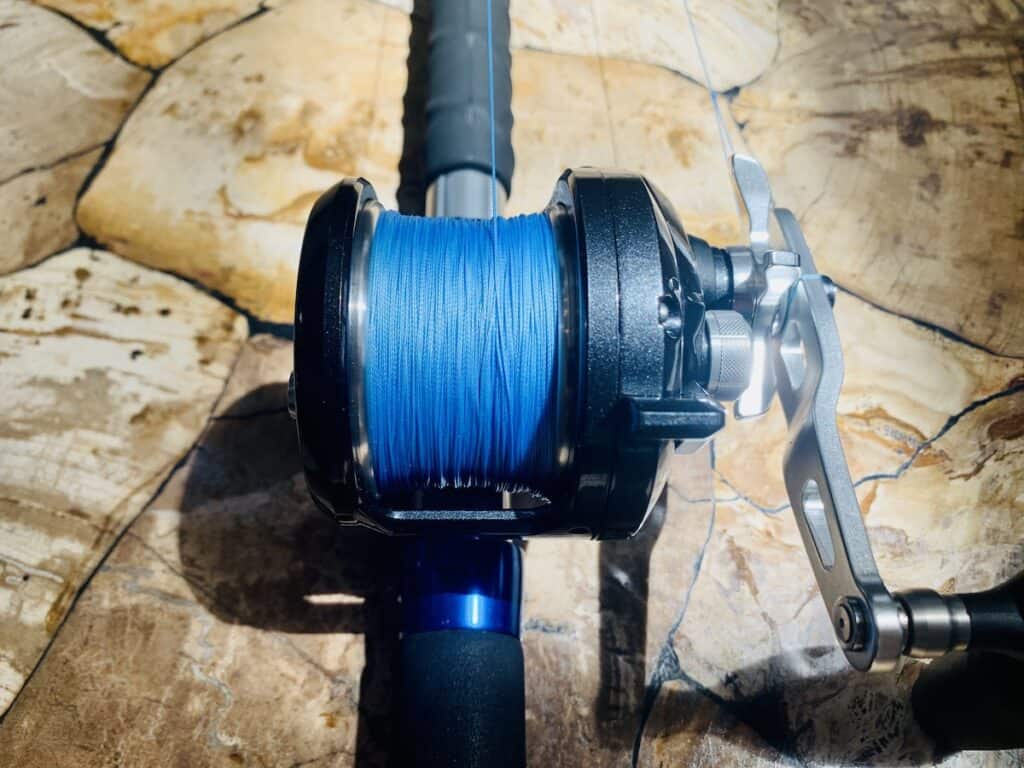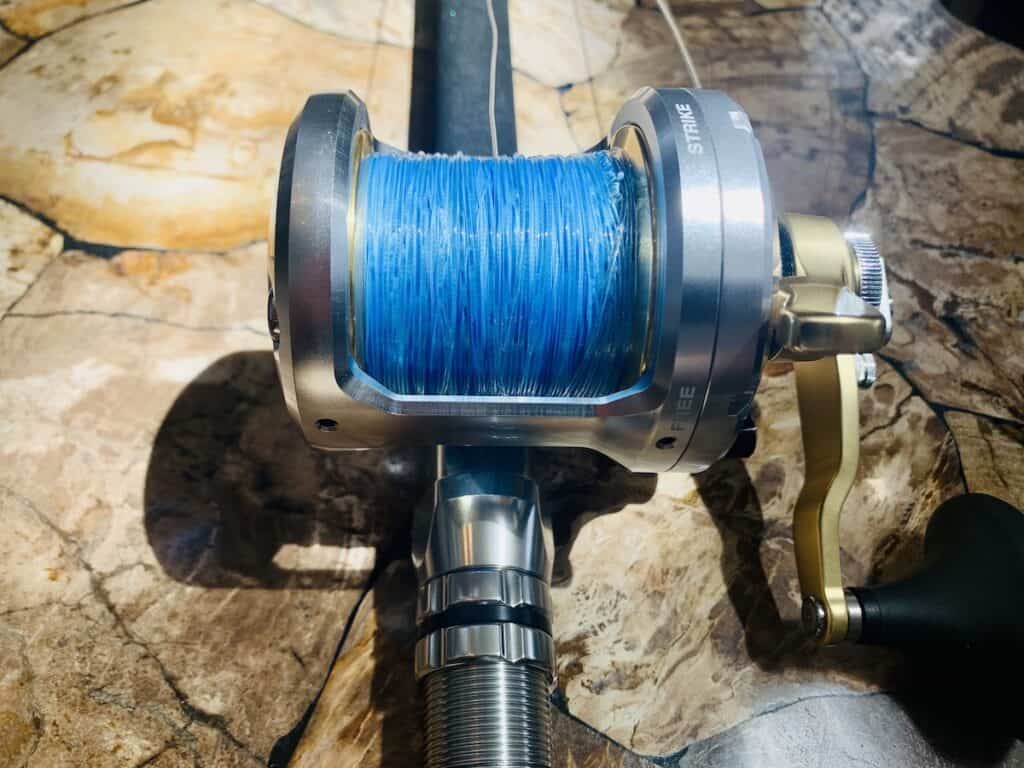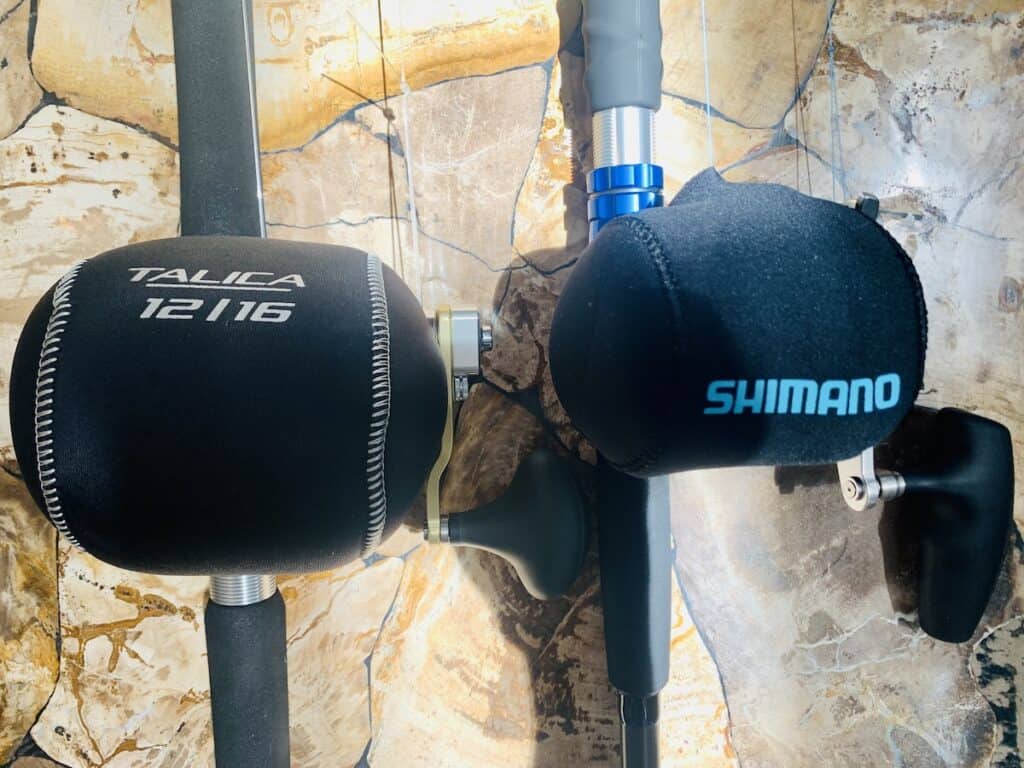When I first set out to choose and buy a bottom reel, I knew I was going to get at least 2 of them. I would get one for myself and one for my wife. I thought about getting a third for a guest, but I figured I’d probably be driving the boat and two would be enough to get started. The reason I mention this up front is because it played a part when deciding the sizes of the reels. Both reels needed to be sized to handle my usual fishery, and I wanted one of them to be able to handle the deeper waters we’ll hit when we vacation in the Keys.
The Shimano Torium PG and the Shimano Talica 2 speed are the best bottom fishing reels out there. They both have low gear ratios to muscle up big grouper and have more than enough drag. They both also have high line capacities to reach the bottom without adding too much size to the reel. Read on to learn how I chose what size was best for bottom fishing.
Spinning vs Conventional Reels for Bottom Fishing
The first decision I needed to make was what style reel did I want. Spinning and conventional reels can both work for bottom fishing, and the best one for you depends on a few factors. A newer angler trying to learn bottom fishing may end up in over his/her head trying not to cause a birds nest while the spool is in freespool and also figuring out how to manually levelwind a bulky conventional reel. A spinning reel would be a good choice for this person.
However, for me, I have a fair amount of fishing experience and am comfortable manually levelwinding a conventional reel while retrieving. I knew I could maximize line capacity with a conventional reel, and get a lower gear ratio and higher power too. The choice between a spinning reel and a conventional reel was a no-brainer for me, and conventional won.
Then I started looking at the conventional reels on the market. I already have a Penn International 16VISX that I use for trolling, so I considered using that one for bottom fishing as well. The reason I did not was simple, I wanted to rig my International with braid, a 100 yard mono topshot, and trolling lures. I wanted a separate setup ready to go for bottom fishing, without having to re-rig when I change techniques.
If you read through my article on Bottom Fishing Line, you’ll see that the leader line only needs to be a few feet long for bottom fishing, so I would have to cut down my mono topshot to use that reel for bottom fishing. I’d rather have a separate setup and I like having a variety of reels so I can use them and write about them for this blog.
Line Capacity for Bottom Fishing
I knew from the get-go that I was going to spool these reels with 65 lb braid. Braid helps maximize the amount of line you can fit on your reel because of the small diameter, and also maximizes sensitivity so you can feel strikes quicker. I also figured that one reel could be on the smaller side.
This would be the one my wife would normally use and would work for most reefs and wrecks that we see within 20 miles of shore between Port Canaveral and Fort Pierce in Florida. These reefs and wrecks are mostly about 60 Fathoms deep (120 yards, 360 feet). Add in a little margin for deeper waters, fighting fish, and overhyped line capacity stats. About 300 yards of 65 lb braid advertised line capacity seemed reasonable to me for the smaller reel.

My article on Bottom Reel Features helps to explain how to go about figuring your line capacity needs.
Now for the second reel, I want it be able to use it for deeper wrecks, reefs, and ledges. I also want to be able to use it when we fish in the Keys. I know I’ll be trolling the Marathon Humps and will probably drift and bottom fish while we’re at it. The depths change rapidly from 450 feet (150 yds) to 86 feet around that area. I could easily find even deeper water a few more miles out, so I was looking at about a 400 yard capacity of 65 lb braid.
I also knew that I wanted one that was a mid price point and one that was a little higher end. This was because I wanted to experience using different reels so I could write about and video about them. I also think expensive reels are cool, so there’s that too, ha.
In the table below, I show a few different sizes of the Shimano Torium and the Shimano Talica so you can see how the line capacity, weight, and price changes with size. At this point, I was still looking at the different sizes and specs and hadn’t decided which reel would be used for which situation. I will add that price was not a driver in my decision.
| Reel | 65 lb Braid Capacity | Weight | Cost |
| Shimano Torium TOR16PGA | 330yds | 19.4 oz | $240 |
| Shimano Torium TOR20PGA | 375yds | 19.8 oz | $250 |
| Shimano Torium TOR30PGA | 515yds | 20.3 oz | $260 |
| Shimano Talica TAC16II | 485yds | 26.5 oz | $590 |
| Shimano Talica TAC20II | 725yds | 32.3 oz | $630 |
There is a significant jump in line capacity between the size 16 and 20 Talica. It was becoming clear that the size 16 Talica would be plenty for my fisheries. I was still undecided about the size 16, 20, or 30 Torium, although it seemed the 30 Torium was likely bigger than we needed. I could tell by the weights that the Torium was likely the one that my wife would preferably use.
Drag for Bottom Fishing
When looking at the table below, you’ll see the max drag is consistently 33 lbs between the size 16, 20, and 30 Torium. The Talica drag specs change between sizes. I knew I wanted to spool the reel with 65 lb braid and would likely set my drag at about 16 or 17 lbs, which is roughly 25% the breaking strength of the line. All of these reels can be set at that line strength, so the max drag comparisons didn’t really help me decide on what size to buy.
| Reel | Max Drag | Max Drag @ Full |
| Shimano Torium TOR16PGA | 33 lbs | N/A |
| Shimano Torium TOR20PGA | 33 lbs | N/A |
| Shimano Torium TOR30PGA | 33 lbs | N/A |
| Shimano Talica TAC16II | 22 lbs (@ strike) | 40 lbs |
| Shimano Talica TAC20II | 30 lbs (@ strike) | 45 lbs |
The Torium has star drag and the Talica has lever drag. I like the idea of having one of each for bottom fishing so my wife and kids can start to figure out which one they prefer to use. They each have their advantages and disadvantages.
Star drags are easy to use because you simply twist the star to increase or decrease the setting. A lot of star drags even click as you adjust them so you can increase the drag by 3 clicks and remember to decrease it by 3 clicks to get it back to where it was. Star drags do get pretty hot though, because the drag washers are smaller and that affects how quickly the heat dissipates from them.

Lever drags are nice because you can visually tell if you moved the lever and changed the drag setting. They also tend to support higher max drags because the drag washers are the same size as the spool diameter, whereas a star drag is the same diameter as the drive gear. The larger surface area also helps heat dissipate faster.
Gear Ratio and Retrieve Rate on Bottom Reels
The gear ratio was the next thing I looked at. For bottom fishing, the low gear ratio is critical for those initial moments after strike. It gives you much needed muscle to prevent a grouper or snapper from darting back into the reef. With the Torium, you need to be looking at the “PG” models instead of the “HG” models for bottom fishing because they have the lower gear ratios.
However, this is also where the two speed reel comes in handy. When you’re bringing in an empty line, or when you’re past that initial strike, a faster retrieval rate can make things much more enjoyable. I decided at this point that the Talica 2 speed would be the reel I would use for deeper waters because of the ability to get a lower gear ratio for more power for the bigger grouper I’ll catch, and a faster retrieve rate for those times I reel in empty handed.
| Reel | Gear Ratio | Retrieve Rate |
| Shimano Torium TOR16PGA | 4.6:1 | 34 IPT |
| Shimano Torium TOR20PGA | 4.6:1 | 34 IPT |
| Shimano Torium TOR30PGA | 4.6:1 | 34 IPT |
| Shimano Talica TAC16II | 5.7:1 High 3.1:1 Low | 41 IPT High 22 IPT Low |
| Shimano Talica TAC20II | 5.2:1 High 2.3:1 Low | 46 IPT High 20 IPT Low |
You’ll notice a difference in the gear ratios between the Talica 16 and 20. The size 20 and up Talica has different gearing to help fishermen handle extremely strong fish. At this point, I was still undecided about which size Talica, although the 20 seemed like it might be overkill for my application.
Anti-Reverse on Bottom Reels
The anti-reverse was something I looked at, although I know it isn’t as critical to bottom fishing as it is to trolling. Anti-reverse is what stops the spool from spinning backwards before the drag engages. In trolling, you’ll see redundant designs with more than one pawl and ratchet.
| Reel | Anti-Reverse |
| Shimano Torium TOR16PGA | Single Pawl + Ratchet |
| Shimano Torium TOR20PGA | Single Pawl + Ratchet |
| Shimano Torium TOR30PGA | Single Pawl + Ratchet |
| Shimano Talica TAC16II | Double Pawl + Ratchet |
| Shimano Talica TAC20II | Triple Pawl + Ratchet |
I was not planning on using either of these reels for trolling since I’m already set up with Penn Internationals for that. I was able to solidify my choice of Talica size by looking at this feature, though. If you look at the table below, you’ll see the Talica size 16 has a double pawl ratchet system and the size 20 has a triple pawl.
This wasn’t surprising to me because the Talica is frequently used for trolling, however it clearly looked excessive for using this reel for bottom fishing. Looking at the anti-reverse solidified that the size 16 Talica was best for me.
Levelwinds on Bottom Reels
Although a levelwind can be helpful to new anglers, I decided that I wanted these reels to last long term and I didn’t want to try to upkeep a levelwind exposed to saltwater. Levelwinds are very prone to corrosion and other kinds of degradation. Although I may have to help initially, I want my kids to learn to use the ideal fishing equipment from the start of their angling days.
Manually levelwinding does require your thumb to move left and right across the spool. This is the primary reason I wanted to choose the smaller size Torium. It was most often going to be the reel my wife and kids would use and they have smaller hands than me.
Conclusion
To make a long story short, I bought a Talica 16 2 speed conventional reel to use as my bottom fishing reel. I couldn’t be happier with it. Although its on the pricey side, I know its built to last as long I properly care for it. Its also small enough that my wife can handle it well for times when I’m driving the boat.
If you can’t tell by now, I’m not fond of having oversized equipment. It drains me after hours and hours of fishing. It took me a little while to finally decide which size Torium I would buy, and ultimately settled on the smaller size 16. It has the line capacity I need and my wife and kids could probably benefit from the narrower spool when learning to manually levelwind. It's a beautiful reel and she loves it spooled with blue braid.
I talked a lot about my specific fishery and who I was buying for in this article. I hope this helps explain how I made my decisions and helps you identify where you might make the same or different choice. Both the Torium and Talica are great reels for bottom fishing.

There are a couple of extra things I like to do with my setups. I like to color code them so I can easily tell someone to grab the bottom setups, they're the ones spooled with blue line. My trolling setups are spooled with a dark green line. I also recommend protecting your investment with reel covers. Here is the Talica reel cover and the Shimano reel cover I got for both of these reels. I keep my rods and reels in my garage so they're susceptible to lots of dust and dirt if left uncovered.
Next up, head over to my article Best Bottom Fishing Rod to find the rods we paired them with. While you're learning about bottom fishing, don't forget to also read my comprehensive guide, here. Tight lines, y’all!
Recent Posts
Fat Cow Jig Strips: The Ultimate Bucktail Jig Upgrade for Surf Fishing
As discussed in my previous article, "Surf Fishing with Bucktail Jigs: Ultimate Guide for Beach Anglers," bucktail jigs are a staple in any surf angler's tackle box, offering a versatile way to catch...
In my previous article, "Surf Fishing with Bucktail Jigs: Ultimate Guide for Beach Anglers," I introduced you to the bucktail jig and discussed how versatile of a lure it is for catching a wide range...

